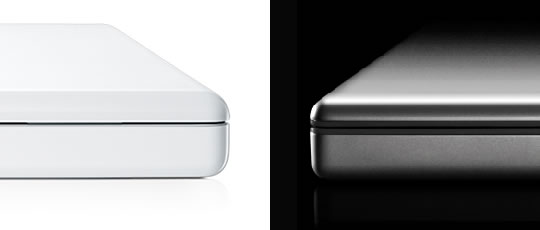Polycarbonate vs Aluminum for Laptops

The MacBook shown at left has a polycarbonate plastic exterior, while the MacBook Pro (right) is aluminum. Both materials have their pros and cons, aluminum is stronger so it can be thinner than plastic yielding sleeker notebooks with that "I'm expensive" look. Also, aluminum may provide better cooling for the interior components of the computer than plastic. But when it comes to durability, my personal experience tells me there's no clear winner. Under impact or stress polycarbonate can dent, and aluminum can warp or dent. However, based on my observations, aluminum can be damaged more easily than plastic. Read on for why polycarbonate might just be a better material for laptops.
Most of my friends with PowerBooks (the aluminum predecessor of the MacBook Pro) have dropped them. And while they all seem to still work, the lids don't close properly anymore, the corners are dented, or the exterior is warped. However, I've never seen an iBook (the polycarbonate predecessor of the MacBook) with anything more than light scratches on the exterior. Polycarbonate is a unbreakable plastic, it's used in bullet proof glass and for CDs. If you've ever tried to break a CD the plastic doesn't really snap as you might expect, instead it just creases like really stiff paper. Under extreme impact Polycarbonate can dent, and if you really go ballistic on it, you can break it. But mostly it just yields to the stress and returns to it's original shape. Like polycarobonate, aluminum can dent on impact. But unlike polycarbonate it bends and warps under stress. It's usually some warping that causes laptop lids to not close correctly.
While Polycarbonate seems to do a better job of protecting itself than aluminum, it's hard to know which actually protects the internal components of the laptop better. On impact polycarbonate may flex enough to dislodge the guts of the laptop, over time a warped aluminum laptop might be able to stress and dislodge the components long after the impact.
Dell posted a video showing some pretty extreme stress test on their Latitude D820, which I don't think is even made out of polycarb. I'd love to see some similar tests done on a MacBook Pro. As much as I love the look of aluminum, I'm not sure if I'd prefer looks over durability. Especially since the polycarbonate laptops from Apple are totally hot too.
If anyone has pictures of a damaged iBook, PowerBook, MacBook, or MacBook Pro they'd like to share please leave a comment with a link to the image.
Comments
Dells X20 series latitudes/precisions have a cast magnesium alloy base and lid,the palm rest is plastic as is the inner lcd bezel.
FYI magnesium is roughly 30% lighter than aluminium and up to 50 % stronger depending how it is alloyed
Posted by: Gerard | May 9, 2007 05:58 AM
Are you kidding? CDs crack and shatter, in a way that sometimes could be described as explosive...the only thing that stops them from exploding is the thin metallic layer (ironically but irrelevantly aluminum). You can flex them a bit, but I have never ever seen a CD "fold." http://images.google.com/images?um=1&hl=en&client=opera&rls=en&q=broken+cd&btnG=Search+Images
Maybe you had a very unusual brand...I've broken several different brands intentionally and accidentally and have never seen anything like that.
I've also seen polycarb sunglass lenses get scratched and snap.
Much of aluminum's problems are easily solved with hard-anodizing. You can make the stuff nearly indestructable, though really high-quality anodizing can cost more. The place I work uses both plastic and aluminum (they are weight/strength/longevity focused products) and the only plastic we'll use is a composite of long glass fibers and nylon. These are load-bearing materials though, so I'm not sure how that translates into something that mainly needs to resist impact. The hard-anodized aluminum we use, however, will go for 20 years in a corrosive environment with extreme stress and impact, and not look any worse for the wear. Better yet, the process makes it a sexy black color with no need for paint.
Posted by: Anonymous | August 3, 2008 10:11 PM
I guess the article makes sense. Thats why car radiator fins is made from aluminum, while copper is the best in dissipating heat. Its because aluminum is easier to mold, hence warp..
In handling everyday bumps and impact i think polycarbonate is better than aluminum. Sturdy feel is different from true sturdy. Its perceived so, not it is.
Posted by: Michael | February 28, 2009 05:21 AM